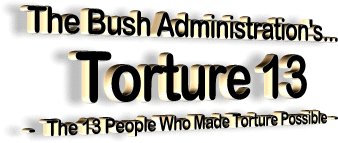1. Dick Cheney, vice president (2001-2009)
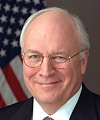
On the morning of 9/11, after the evacuation
of the White House, Dick Cheney summoned his legal counsel, David
Addington, to return to work.
The two had worked together for years. In
the 1980s, when Cheney was a congressman from Wyoming and Addington a
staff attorney to another congressman, Cheney and Addington argued that
in Iran-Contra, the president could ignore congressional guidance on
foreign policy matters. Between 1989 and 1992, when Dick Cheney was the
elder George Bush's secretary of defense, Addington served as his
counsel.
He and Cheney saved the only known copies of
abusive interrogation technique manuals taught at
the School of the
Americas. Now, on the morning of 9/11, they worked together to plot an
expansive grab of executive power that they claimed was the correct
response to the terrorist threat.
Within two weeks,
they had gotten a memo
asserting almost unlimited power for the president as "the sole organ of
the Nation in its foreign relations," to respond to the terrorist
attacks. As part of that expansive view of executive power, Cheney and Addington would argue that domestic and international laws prohibiting
torture and abuse could not prevent the president from authorizing harsh
treatment of detainees in the
war against terror.
But Cheney and Addington also fought bureaucratically to construct this
torture program. Cheney led the way by controlling who got access to
President Bush - and making sure
his own views preempted others'. Each
time the torture program got into trouble as it spread around the globe,
Cheney intervened to ward off legal threats and limits, by
badgering the
CIA's inspector general when he reported many problems with the
interrogation program, and
by lobbying Congress to legally
protect those
who had tortured.
Most shockingly,
Cheney is reported to have ordered torture himself,
even after interrogators believed detainees were cooperative.
Since the 2002 OLC memo known as "Bybee Two"
that authorizes torture premises its authorization for torture on the
assertion that "the interrogation team is certain that" the detainee
"has additional information he refuses to divulge," Cheney appears to
have ordered torture that was illegal even under the spurious guidelines
of the memo.
2. David Addington, counsel to the vice
president (2001-2005), chief of staff to the vice president (2005-2009)

David Addington championed the fight to
argue that the president - in his role as commander in chief - could not
be bound by any law, including those prohibiting torture. He did so in
two ways.
He advised the lawyers drawing up the legal opinions that
justified torture. In particular, he ran a "War Council" with
Jim Haynes, John Yoo, John Rizzo and Alberto Gonzales (see all four
below) and other trusted lawyers, which crafted and executed many of the
legal approaches to the war on terror together.
Quantcast
In addition, Addington and Cheney wielded bureaucratic carrots and
sticks - notably by
giving or withholding promotions for lawyers who
supported these illegal policies. When
Jack Goldsmith withdrew a number
of OLC memos because of the legal problems in them,
Addington was the
sole administration lawyer who defended them.
Addington's close bureaucratic control over
the legal analysis process shows he was unwilling to let the lawyers
give the administration a "good faith" assessment of the laws
prohibiting torture.
3. Alberto Gonzales, White House
counsel (2001-2005), and attorney general (2005-2008)
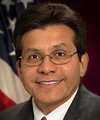
As White House counsel, Alberto Gonzales was
nominally in charge of representing the president's views on legal
issues, including national security issues. In that role, Gonzales wrote
and reviewed a number of the legal opinions that attempted to immunize
torture. Most important, in a Jan. 25, 2002, opinion reportedly written
with David Addington, Gonzales paved the way for exempting al-Qaida
detainees from the Geneva Conventions.
His memo claimed the "new kind of war"
represented by the war against al-Qaida,
"renders obsolete Geneva's strict
limitations on questioning of enemy prisoners."
In a signal that Gonzales and Addington
adopted that position to immunize torture, Gonzales argued that one
advantage of not applying the Geneva Convention to al-Qaida would,
"substantially reduce the threat of
domestic criminal prosecution under the War Crimes Act."
The memo even specifically foresaw the
possibility of independent counsels' prosecuting acts against detainees.
4. James Mitchell, consultant

Even while Addington, Gonzales and the
lawyers were beginning to build the legal framework for torture, a
couple of military psychologists were laying out the techniques the
military would use. James Mitchell, a retired military psychologist, had
been a leading expert in the military's SERE program.
In December 2001, with his partner, Bruce
Jessen, Mitchell reverse-engineered SERE techniques to be used to
interrogate detainees. Then, in the spring of 2002, before OLC gave
official legal approval to torture, Mitchell oversaw Abu Zubaydah's
interrogation. An FBI agent on the scene describes Mitchell overseeing
the use of "borderline torture."
And after OLC approved waterboarding,
Mitchell oversaw its use in ways that exceeded the guidelines in the OLC
memo. Under Mitchell's guidance, interrogators used the waterboard with
"far greater frequency than initially indicated" - a total of 183 times
in a month for Khalid Sheikh Mohammed and 83 times in a month for Abu
Zubaydah.
5. George Tenet, director of Central
Intelligence (1997-2004)
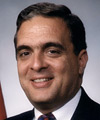
As director of the CIA during the early
years of the war against al-Qaida, Tenet had ultimate management
responsibility for the CIA's program of capturing, detaining and
interrogating suspected al-Qaida members and briefed top Cabinet members
on those techniques.
Published reports say Tenet approved every
detail of the interrogation plans:
"Any change in the plan - even if an
extra day of a certain treatment was added - was signed off on by
the Director."
It was under Tenet's leadership that
Mitchell and Jessen's SERE techniques were applied to the
administration's first allegedly high-value al-Qaida prisoner, Abu
Zubaydah. After approval of the harsh techniques, CIA headquarters
ordered Abu Zubaydah to be waterboarded even though onsite interrogators
believed Zubaydah was "compliant."
Since
the Bybee Two memo authorizing torture
required that interrogators believe the detainee had further information
that could only be gained by using torture, this additional use of the waterboard was clearly illegal according to the memo.
6. Condoleezza Rice, national security
advisor (2001-2005), secretary of state (2005-2008)
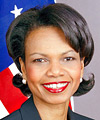
As national security advisor to President
Bush, Rice coordinated much of the administration's internal debate over
interrogation policies.
She approved (she now says she "conveyed the
authorization" - below video) for the first known officially sanctioned use of torture
- the CIA's interrogation of Abu Zubaydah -
on July 17, 2002.
This
approval was given after the torture of Zubaydah had begun, and before
receiving a legal OK from the OLC.
The approval from the OLC was given orally
in late July and in written form on Aug. 1, 2002. Rice's approval or "convey[ance]
of authorization" led directly to the intensified torture of Zubaydah.
7. John Yoo, deputy assistant attorney
general, Office of Legal Counsel (2001-2003)

As deputy assistant attorney general of OLC
focusing on national security for the first year and a half after 9/11,
Yoo drafted many of the memos that would establish the torture regime,
starting with the opinion claiming virtually unlimited power for the
president in times of war.
In the early months of 2002, he started
working with Addington and others to draft two key memos authorizing
torture: Bybee One (providing legal cover for torture) and Bybee Two
(describing the techniques that could be used), both dated Aug. 1, 2002.
He also helped draft a similar memo approving harsh techniques for the
military completed on March 14, 2003, and even a memo eviscerating
Fourth Amendment protections in the United States.
The Bybee One and DOD memos argue that
"necessity" or "self-defense" might be used as defenses against
prosecution, even though
the United Nations Convention Against Torture
explicitly states that,
"no exceptional circumstances
whatsoever, whether a state of war or a threat or war… may be
invoked as a justification of torture."
Bybee Two, listing the techniques the CIA
could use in interrogation, was premised on hotly debated assumptions.
For example, the memo presumed that Abu Zubaydah was uncooperative, and
had actionable intelligence that could only be gotten through harsh
techniques. Yet
Zubaydah had already cooperated with the FBI.
The memo claimed Zubaydah was mentally and
physically fit to be waterboarded, even though Zubaydah had had head and
recent gunshot injuries.
As
Jack Goldsmith described Yoo's opinions,
they,
"could be interpreted as if they were designed to confer immunity
for bad acts."
In all of his torture memos, Yoo ignored key
precedents relating both
specifically to waterboarding and to separation
of powers.
8. Jay Bybee, assistant attorney
general, Office of Legal Counsel (2001-2003)
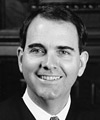
As head of the OLC when the first torture
memos were approved, Bybee signed the memos named after him that
John Yoo drafted. At the time, the White House knew that Bybee wanted an
appointment as a Circuit Court judge; after signing his name to memos
supporting torture,
he received such an appointment. Of particular
concern is the timing of Bybee's approval of the torture techniques.
He first
approved some techniques on July
24, 2002. The next day, Jim Haynes, the Defense Department's general
counsel, ordered the SERE unit of DOD to collect information including
details on waterboarding. While the record is contradictory on whether
Haynes or CIA General Counsel John Rizzo gave that information to OLC,
on the day they did so,
OLC approved waterboarding.
One of the documents in that packet
identified these actions as torture, and stated that
torture often
produced unreliable results.
Quantcast
9. William "Jim" Haynes, Defense
Department general counsel (2001-2008)
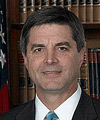
As general counsel of the Defense
Department, Jim Haynes oversaw the legal analysis of interrogation
techniques to be used with military detainees. Very early on, he worked
as a broker between SERE professionals and the CIA. His office first
asked for information on "exploiting" detainees in December 2001, which
is when James Mitchell is first known to have worked on interrogation
plans.
And later, in July 2002, when CIA was
already using torture with Abu Zubaydah but needed scientific cover
before OLC would approve waterboarding, Haynes ordered the SERE team to
produce such information immediately.
Later Haynes played a key role in making sure some of the techniques
were adopted, with little review, by the military. He was thus crucial
to the migration of torture to Guantánamo and then Iraq. In September
2002, Haynes participated in a key visit to Guantánamo (along with
Addington and other lawyers) that coincided with requests from DOD
interrogators there for some of the same techniques used by the CIA.
Haynes
ignored repeated warnings from within the armed services about
the techniques, including statements that the techniques "may violate
torture statute" and "cross the line of 'humane' treatment."
In October
2002, when the legal counsel for the military's Joint Chiefs of Staff
attempted to conduct a thorough legal review of the techniques, Haynes
ordered her to stop, because "people were going to see" the objections
that some in the military had raised.
On Nov. 27, 2002, Haynes recommended that
Secretary of Defense Donald Rumsfeld authorize many of the requested
techniques, including stress positions, hooding, the removal of
clothing, and the use of dogs - the same techniques that showed up later
in
the abuse at Abu Ghraib.
10. Donald Rumsfeld, secretary of
defense (2001-2006)
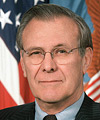
As secretary of defense, Rumsfeld signed off
on interrogation methods used in the military, notably for Abu Ghraib,
Bagram Air Force Base and Guantánamo Bay. With this approval, the use of
torture would move from the CIA to the military.
A
recent bipartisan Senate report concluded
that,
"Secretary of Defense Donald Rumsfeld's
authorization of interrogation techniques at Guantánamo Bay was a
direct cause of detainee abuse there."
Rumsfeld personally approved techniques
including the use of phobias (dogs), forced nudity and stress positions
on Dec. 2, 2002, signing a one-page memo prepared for him by Haynes.
These techniques were among those deemed
torture
in the Charles Graner case and the
case of "20th hijacker"
Mohammed al-Qahtani. Rumsfeld also
personally authorized an
interrogation plan for Moahmedou Ould Slahi on Aug. 13, 2003; the plan
used many of the same techniques as had been used with al-Qahtani,
including sensory deprivation and "sleep adjustment."
And through it all, Rumsfeld maintained a
disdainful view on these techniques, at one point quipping on a memo
approving harsh techniques,
"I stand for eight to 10 hours a day.
Why is standing limited to four hours?"
11. John Rizzo, CIA deputy general
counsel (2002-2004), acting general counsel of the Central Intelligence
Agency (2001-2002, 2004-present)

As deputy general counsel and then acting
general counsel for the CIA, John Rizzo's name appears on all of the
known OLC opinions on torture for the CIA.
For the
Bybee Two memo, Rizzo provided a
number of factually contested pieces of information to OLC - notably,
that Abu Zubaydah was uncooperative and physically and mentally fit
enough to withstand waterboarding and other enhanced techniques. In
addition,
Rizzo provided a description of waterboarding using one
standard, while the OLC opinion described
a more moderate standard.
Significantly, the description of waterboarding submitted to OLC came
from the Defense Department, even though NSC had excluded DOD from
discussions on the memo.
Along with the description of waterboarding
and other techniques,
Rizzo also provided a document that called
enhanced methods "torture" and deemed them unreliable - yet even with
this warning, Rizzo still advocated for the CIA to get permission to use
those techniques.
12. Steven Bradbury, principal deputy
assistant attorney general, OLC (2004), acting assistant attorney
general, OLC (2005-2009)

In 2004, the CIA's inspector general
wrote a
report concluding that the CIA's interrogation program might violate the
Convention Against Torture. It fell to Acting Assistant Attorney General
Steven Bradbury to write three memos in May 2005 that would dismiss the
concerns the IG Report raised - in effect, to affirm the OLC's 2002
memos legitimizing torture.
Bradbury's memos noted the ways in which
prior torture had exceeded the Bybee Two memo: the 183 uses of the
waterboard for Khalid Sheikh Mohammed in one month, the gallon and a
half used in waterboarding, the 20 to 30 times a detainee is thrown
agains the wall, the 11 days a detainee had been made to stay awake, the
extra sessions of waterboarding ordered from CIA headquarters even after
local interrogators deemed Abu Zubaydah to be fully compliant.
Yet Bradbury does not consider it torture.
He notes the CIA's doctors' cautions about the combination of using the
waterboard with a physically fatigued detainee, yet
in a separate memo
approves the use of sleep deprivation and waterboading in tandem. He
repeatedly concedes that the CIA's interrogation techniques as actually
implemented exceeded the SERE techniques, yet repeatedly points to the
connection to SERE to argue the methods must be legal.
And as with the Bybee One memo, Bradbury
resorts to precisely the kind of appeal to exceptional circumstances -
"used only as necessary to protect against grave threats" - to
distinguish U.S. interrogation techniques from the torture it so closely
resembles around the world.
13. George W. Bush, president
(2001-2009)
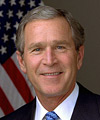
While President
Bush maintained some
distance from the torture for years - Cheney describes him "basically"
authorizing it (below video) - he served as the chief propagandist about its efficacy
and necessity.
Most notably, on Sept. 6, 2006, when Bush
first confessed to the program,
Bush repeated the claims made to support
the Bybee Two memo: that Abu Zubaydah wouldn't talk except by using
torture.
And in 2006, after the CIA's own inspector
general had raised problems with the program, after Steven Bradbury had
admitted all the ways that the torture program exceeded guidelines, Bush
still claimed it was legal.
"[They] were designed to be safe, to
comply with our laws, our Constitution and our treaty obligations.
The Department of Justice reviewed the authorized methods
extensively, and determined them to be lawful."
With this statement, the deceptions and
bureaucratic games all came full circle. After all, it was Bush who, on
Feb. 7, 2002, had
declared the Geneva Conventions wouldn't apply (a view
the Supreme Court ultimately rejected).
Bush's inaction in torture is as important as his actions. Bush failed
to fulfill legal obligations to notify Congress of the torture program.
A
Senate Intelligence timeline on the torture program makes clear that
Congress was not briefed on the techniques used in the torture program
until after Abu Zubaydah had already been waterboarded.
And in a 2003 letter, then House
Intelligence ranking member Jane Harman shows that she had not yet seen
evidence that Bush had signed off on this policy. This suggests
President Bush did not provide the legally required notice to Congress,
violating
National Security Decisions Directive-286. What Bush did not
say is as legally important as what he did say.
Yet, ultimately, Bush and whatever approval he gave the program is at
the center of the administration's embrace of torture.
Condoleezza Rice
recently said,
"By definition, if it was authorized by the president, it
did not violate our obligations in the Convention Against Torture."
While Rice has tried to reframe her statement, it uses the same logic
used by John Yoo and David Addington to justify the program, the
shocking claim that international and domestic laws cannot bind the
president in times of war.
Bush's close allies still insist if he
authorized it, it couldn't be torture.
